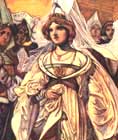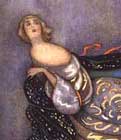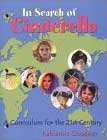
Cinderella:
345 Variants
by Marian
Roalfe Cox
SurLaLune's
Cinderella Area
SurLaLune Fairy Tales Main Page
42
Grundtvig, S., Unpublished Collection.(Told and written down by Mr. Palle Floe, Surveyor, West Jutland.)
"ASKEPOT"
(Pot of Ashes).
ABSTRACT
Ill-treated heroine (by step Hearth abode--Helpful animal (dog) sweeps for heroine; sends her to lime-tree which gives Magic dresses, (church)--Threefold flight--Step-mother has (1) garden-wall, (2) peat-heal), (3) bakehouse demolished, because heroine pretends to have had look out thence--Pitch trap --Lost shoe--Shoe marriage test--Mutilated feet--Animal witness (birds)--Happy marriage.
TABULATION
(1) Widow and daughter go to church. Askepot, the stepdaughter, must sit at home on the hearth.-- (2) Dog offers to wash and sweep for her, and bids her go to limetree, and get a dress, carriage, and horses, and go to church. King's son sees Askepot, whose beauty makes him forget parson, sermon, and alI.-- (3) Stepmother and stepsister return and tell Askepot of the lovely girl. Askepot says she saw her pass by from the earth-wall1 round the garden. To thwart her, stepmother has wall removed.-- (4) Next Sun. day, all happens as before. King's son tries in vain to catch Askepot.-- (5) Stepmother has the peat-heap scattered, because heroine says she was watching thence.-- (6) On the third Sunday the king's son has the church entrance smeared with tar, and heroine loses a gold shoe.-- (7) Stepmother has the bakehouse2 pulled down, because heroine pretends to have seen the fair unknown thence.-- (8) King's son will marry whomsoever the gold shoe fits. Mothers arrive in hundreds with their daughters, who jet vain cut heel and toe. Askepot comes too, but cannot get entrance because of the crowd at the front door; so she goes in at the kitchen door, and rests by the hearth.-- (9) Owner of the house understands language of birds,3 and hears them singing:
"Some cut their heel, and souse their toe,
But she ails by the hearth who can wear the shoe."
(10) He tells king's son, who goes to kitchen, puts shoe on heroine's foot, and marries her.
NOTES
1: The gardens in Denmark
are surrounded by an earth-wall of several feet in height, from the top
of which girls commonly watch the passers-by.-- F.
Return to place in text.
2: Oven and kneading-trough are
in a small separate building, which may be easily climbed.
Return to place in text.
Note 32
(P. 235.) Frequently the knowledge of birds' language comes of eating a white snake, as in Grimm's No. 17; Wratislaw, Sixty (Slavonic) Folk-tales, p. 25. Sigfred, in the Old Play of the Wolsungs (Corpus Poet. Boreale, i, 39), like Sigurd in the Western Wolsung-Lay (C. P. B., i, 157) understands the birds' talk when he has tasted the heart of the dragon Fafni. In the saga of the Seeburg (Deut. Sag., No. 131) the serving-man tastes a piece of a silver-white snake, and immediately knows what the fowls, ducks, geese, doves, and sparrows in the yard are saying of the speedy downfall of the castle. There are various similar legends of submerged castles. For other examples of the wisdom-giving fish, or snake, cf. Campbell, ii, 361, 363, and see 366, No. 47 (white snake); iii, 331, No. 82 (Fionn), and see p. 297; Chambers, Tales of Sir James Ramsay; Chodzko, Contes des Paysans . . . . Slaves, "Dieva Zlato Vlaska"; Cox, Aryan Myth., i, 81; Darles, Mythol. Celtique; Folk-lore Journal, vi, 299 ff. (white snake); Baring Gould, Cur. Myths (1871), 260; Kennedy, Legendary Fictions, p. 216, "Farquhar the Physician"; Mabinogion, (Guest), ed. 1877, pp. 471 ff.; Myvyrian Archaiol. of Wales; Rasmann, Deutsche Heldensage, i, 124; Sebillot, H. Bretagne, ii, 224, 326-7; Vuk Stevanovich, Serbische Märchen, No. 3; La Tradition, 1889, No. ii, 33-40; Volsunga-Saga (Camelot Series), pp. 64, 92.
Pliny says (29, 4), "quin et inesse serpenti remedia multa creduntur…..ut possint avium sermones intelligi." Kassandra the prophetess had been licked by a serpent. (See Tzetzes' Argument to Lycophron's Alexandra; also Eustathius, the Homeric scholiast's remarks about Helenus, brother of Kassandra, ad Iliad, vii, 44). Compare the Melampus myth (Apollodorus, i, 9; see also iii, 6, for the story of Teiresias, in which serpents figure. Pliny, x, 137, throws doubt on the story of Melampus). Michael Scott obtained his wisdom by serpents' bree (brigh); cf. Inferno, canto xx; Scott's Lay of Last Minstrel, canto ii, and notes in Appendix. So in Pliny (Nat. Hist., 1. x, cap. 49), "quarum confuso sanguine serpens gignatur, quem quisque ederit, intellecturus sit alitum colloquid." According to a Scotch saga, the middle piece of a white snake, roasted by the fire, gives a knowledge of supernatural things to anyone who shall put his finger into the fat which drops from it. (See Grant Stewart, pp. 82, 83.) In Iceland, one sufficiently safe way of acquiring a knowledge of the language of birds is recorded (Arnason, cxvi): "Take the tongue of a hawk, and put it in honey for two days and three nights; place it then under your own tongue, and you will understand the language of birds. It must not, however, be carried elsewhere than under the tongue, for the hawk is a poisonous bird."
In other cases the knowledge of birds' talk is acquired by means of a herb. Thus, in the poem of Elegast there occurs a nameless herb, which one need only put in the mouth to understand what the cocks crow and the dogs bark. Villemarqui says, whoever accidentally steps on the golden herb (possibly the mistletoe) falls asleep directly, and understands the speech of dogs, wolves, and birds (see Grimm, T. M., pp. 1207, 1682). A wort, that the mermaid dug on the mount that might not be touched, makes whoever eats it underatand the wild beasts, fowl, and fish (Haupt, Zeitschrift, 5, 8, 9). In Ralston's Songs of the Russian People, p. 99, a fern enables one to understand secret things. Mr. Frazer says "On Midsummer Eve the fern is believed to burst into a wondrous bloom. . . . Whoever catches this bloom . . . . can make himself invisible, can understand the language of animals, and so forth" (Golden Bough, ii, 286-7). He gives the following references:-- Wutke, Der deutsche Volksaberglaube, § 123; Grohmann, Aberglauben und Gebrauche aus Bohmen und Mahren, §§ 673-677; Gubernatis, Mythol. des Plantes, ii, 144 sq.; Friend, Flowers and Flower-lore, p. 362; Brand, Pop. Ant., i, 314; Vonbun, Beiträge zur deutschen Mythologie, p. 133 sq.; Burne and Jackson, Shropshire Folk-lore, p. 242; cp. Arch. Rev., i, 164 sq.
In the story of "The Three Languages" (Grimm, No. 33) the lad was three years learning what the dogs bark, what the birds say, and what the frogs croak. Kin-the-young, in the Lay of Righ, learnt the language of birds (Corpus P. Boreale, i, 242). Compare No. 10 and the following:--Boner, Transylvania, p. 372; Day, Folk-tales of Bengal, 150, 152; Denton, Serbian Folk-lore, "The Snake's Gift"; Fleury, Litt. orale Basse-Normandie, p. 123; Grimm, Household Tales, ii, 541 ff.; Gubernatis Z. M., i, 152; Hahn, No. 37; Ind. Ant., iii, 250; Leger, Contes slaves, No. 11, p. 235; Magyar Folk-tales, p. 301, and notes, p. 421; Naaki, Slavonic Tales, "The Language of Animals"; Payne, Arabian Nights, I, 14; Prohle, Kindermärchen, No. 7; Deutsche Sagen, i, 131; Sagas from the Far East, p. 21; Satuja ja Tarinoita, iii, p. 37; Schreck, Nos. 3, 6; Straparola, 12th Night, fable 3; Tales of the Alhambra, "Legend of Prince Ahmed al Kamel"; Tylor, Prim. Cult., i, 190, 469; Webster, p. 136; Wright, The Seven Sages, p. 106, "The Ravens"; etc. And see Philostr., Vit. Ap., i, 20 fin. Arabian and Persian traditions represent Solomon as acquainted with the language of beasts and birds.
In an Icelandic tale a bird understands and speaks the tongue of men (Arnason, 430).
See note on Talking
Birds.
Return to place in text.
Cox, Marian Roalfe. Cinderella: Three Hundred and Forty-five Variants of Cinderella, Catskin, and Cap O' Rushes, abstracted and tabulated. London: David Nutt for the Folklore Society, 1893.
While the original text of this book is out of copyright, the special formatting and compilation available on SurLaLune Fairy Tales is copyrighted. Be aware that while the original content has been honored, page numbering, footnote numbering, redesigned charts, links, and other aspects are unique to this site's version of the text. Use at your own risk. For private and fair use educational purposes only.
©Heidi
Anne Heiner, SurLaLune Fairy Tales
E-mail: surlalune@aol.com
Page last updated February 1, 2006
www.surlalunefairytales.com










